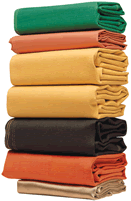
SELECT
A CHART
Heat Fabric Chart
Hot Materials Handling Chart
Size Charts
Comfort and Dexterity Chart
 |
FDP
Flame proof duck. 14.9 ounce per square yard. Fire,
water and mildew resistant, green color, 36"x100 yd.
rolls, up to 400°F.
NLFG
Neoprene coated fiberglass, 16 ounce per square yard,
salmon color, 38"x 50 yd. rolls, up to 400°F. (Also
available in 60" width.)
LFG
Fiberglass, 21 ounce per square yard. Neoprene coated
on one side, yellow color, 40"x 50 yard rolls, up to
1000°F. (Also available in 60" width.)
FG
Fiberglass, 26 ounce per square yard. Neoprene coated
on one side, yellow color, 40"x 50 yard rolls, up to
1000°F. (Also available in 60" width.) |
WFX
Fiberglass, 26 ounce per square yard. Special treatment
to repel sparks and slag, black color, 40"x 50 yard
rolls, up to 1000°F. (Also available in 60" width.)
OFG
Fiberglass, 32 ounce per square yard. Orange color,
40"x 50 yard rolls, up to 1000°F. (Also available in
60" width.)
SGC
Silica cloth, 17 ounce per sq. yard. Off white color,
34"x 50 yard rolls, up to 3000°F.
Top
|
 |
HIGHEST
HEAT
To reduce seam exposure and heat transfer, mittens are
suggested at the highest heat applications. Different
combinations of heavyweight fabrics and linings are
recommended to protect from heat. Cover mittens and
cover gloves should be used in these high heat situations
to add additional layers between the source of the heat
and the hand. Fabrics to be considered at the highest
temperature ranges include PBI® , PBI and Kevlar ® blend,
and treated fiberglass.
HIGH HEAT
Combinations of fabrics and materials are still very
important in this temperature range. Although several
layers of each should be used to protect from the heat,
more dexterity can result by reducing the number of
layers due to lower heat exposure. The same fabrics
can be used in this category as the higher heat category,
only in lighter weight versions. 22-30 ounce fabrics
can be considered.
MODERATE HEAT
In moderate heat applications, fiberglass and Kevlar
outer fabrics are used. Although layering is still important,
more options are available in regards to abrasion characteristics.
As with the other two categories, large full cut patterns
are still suggested in this category.
LOWER HEAT
In lower heat situations, single layers of fiberglass
and Kevlar in combination with wool and other liners
are suggested. Leather is also considered in conjunction
with wool and Nomex® linings. In the lower levels of
this category, single ply leather and liner products
can be used.
Top
|
SHIRTS
| SIZE |
Small
|
Medium
|
Large
|
X-Large
|
| Sleeve |
33
|
34
|
35
|
36
|
| Neck |
15
|
16
|
17
|
17
|
Top
JACKETS AND COATS
| SIZE |
Small
|
Medium
|
Large
|
X-Large
|
XX-Large
|
| Chest |
38
|
42
|
46
|
50
|
54
|
| Sleeve |
32
|
33
|
33
|
34
|
35
|
| Neck |
17
|
18
|
18
|
19
|
20
|
Top
COVERALLS
| SIZE |
Small
|
Medium
|
Large
|
X-Large
|
XX-Large
|
XXX-Large
|
| Chest |
34 - 36
|
38 - 40
|
42 - 44
|
46 - 48
|
50 - 52
|
54 - 56
|
| Waist |
34
|
36
|
38
|
40
|
44
|
46
|
| Hip |
36
|
40
|
44
|
48
|
52
|
56
|
| Leg Inseam |
32
|
32
|
32
|
32
|
32
|
32
|
| Sleeve Length,
Center Back |
29
|
31
|
33
|
35
|
36
|
37
|
| Sleeve Lenth,
Shoulder |
22
|
23
|
24
|
25
|
26
|
27
|
| Sleeve Inseam |
18
|
19
|
20
|
21
|
22
|
22
|
| Trunk |
32
|
32
|
32
|
32
|
34
|
36
|
| Neck |
14
|
15
|
16
|
17
|
18
|
19
|
Top
|
TIG
LEATHER GUIDE
Choosing the right leather makes the difference! Use
the cart below to help decide on the right TIG leather
for the job. In general, thinner, more supple leather
has the least loss of dexterity while thicker leather
provides more durability.
 |
DEERSKIN
By nature soft and supple. Maxim dexterity and
warmth. Used in applications where sensitivity
and feel are required. |
 |
CAPESKIN
Sheepskin, hair sheep, capeskin sot and supple
grain leather used in applications where maximum
dexterity and sensitivity are required. |
 |
GOATSKIN
A strong leather with natural lanolin content.
Lanolin provides a small degree of water repellence
and also comfort to the hands. For light to medium
applications. |
 |
COWHIDE
Grain cowhide is commonly used in drivers and
linemans gloves. Strong and supple, conforms to
the wearer's hand. |
 |
PIGSKIN
somewhat comfortable but extremely tough and flexible
even after becoming wet. Hair follicles go all
the way through the grain. Therefore, pigskin
leather is naturally "air conditioned". |
TIG LEATHER COMFORT VS.
DURABILITY CHART
| |
Deerskin
|
Capeskin
|
Goatskin
|
Cowhide
|
Pigskin |
| Comfort |
•••••
|
••••
|
•••
|
••
|
••
|
| Durability |
•
|
••
|
•••
|
••••
|
••••• |
Top
|
|
|
|